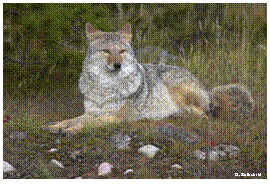Canis latrans

Prior to European colonization coyotes were primarily distributed in the mid-western prairies where they prospered in the grasslands and the forest outskirts. By the early 1900’s coyotes started a northeastern migration up into Canadian territories and then south across the St. Lawrence River into New York state and later, by the 1950’s, into the northwestern portion of Connecticut where the coyote became an established species by the late 1960’s.
With nearly 40 years of adaptation and assimilation into Connecticut habitats coyote populations are healthy and robust. The species has proven to be successful at inhabiting nearly every type of environment, even densely human populated areas. The coyote owes its triumphant success primarily to fact that it can eat most any food available and continue to survive and multiply.
It has been said that a coyote will eat anything it can chew. What the coyote eats can range from fruits and vegetables, to garbage and insects, carcass scavenging, the occasional house pet, pet food, bird seed, livestock and hunted prey. Prey species include small mammals, particularly rodents, rabbits and occasionally they can and do kill deer. For coyotes, hunting and consuming small mammals is an environmentally stable strategy, they shouldn’t modify their food habits unless humans make new ways of attaining nutrient needs easy and reliable.
Most of the time, coyotes will go out of their way to avoid humans, but as people expand their living areas and coyotes continue to utilize edge habitat created by disturbance, contact is inevitable. The issue of dealing with coyotes will not be solved by removing them. Dispatching or relocating a coyote individual rarely brings the desired outcome as another coyote will eventually take over the home range and the next coyote could be more problematic to humans than the last. The only practical solution is education and prevention, with a primary goal of coexistence. Unless coyotes are truly a nuisance or a danger to you and your family they should be left alone. If you feel it is necessary to deal with a problem coyote always contact a professional wildlife manager for advice and help with the situation.

To prevent coyotes from becoming further habituated to humans and human occupied areas please follow these tips:
- Never feed coyotes intentionally or unintentionally. Be aware of possible sources of food in your yard.
- Do not leave uneaten pet food outside.
- Do not discard edible garbage where coyotes can get into it.
- Secure garbage containers and eliminate their odors. Use a small amount of ammonia or cayenne pepper in the garbage to discourage scavenging.
- Restrict use of birdseed. Coyotes are attracted to seed, and to the birds and rodents that use the feeder.
- Wherever possible, eliminate outdoor sources of water. Be aware that coyotes will prey on coy fish if the fish do not have proper cover or a deep enough pond.
- Trim and clear ground level shrubs that can provide cover for coyotes.
- Use fencing to help deter coyotes. The fence must be at least six feet tall with the bottom extending at least six inches below ground level.
- Actively discourage coyotes by making loud noises. Motion detector lights and alarm systems can also help from keeping coyotes out of your yard.
- Pick fruit as soon as it ripens and keep rotted fruit off the ground.
- Scattered mothballs and ammonia-soaked rags strategically placed may deter coyotes from entering your yard.
- Keep cats and small dogs indoors, allowing them outside only under strict supervision.
- Keep chickens, rabbits and other small animals in well-protected areas and in sturdy cages at night. Cages made of chicken wire are meant only for keeping small animals contained, not to keep coyotes out!
- Coyotes are attracted to, and can mate with unspayed or unneutered domestic dogs. Unspayed female dogs in season will attract male coyotes, and unneutered male dogs can be lured away by the scent of a female coyote. There have been cases of male dogs being lured by the female coyote's scent and then killed by male coyotes.
- If you do not mind sharing your space with coyotes, enjoy observing them with binoculars when they visit.
Coyotes are shy and a lot of patience is required to observe them. Coyotes will appear most often during the hours close to sunrise and sunset. In urban areas, coyotes may be a little bit bolder. Do not attempt to approach a coyote. It will most likely run away, but any cornered or frightened wild animal can be dangerous. Most importantly enjoy the brief and fortunate opportunity to observe one of the wild kingdom’s most amazing creatures. We all have something to learn from the coyote’s adaptable and undefeatable nature.
Information was provided by the Connecticut Department of Environmental Protection Wildlife Fact Sheets, Desert USA Fund for Animals, G. Parker’s Eastern Coyote: The Story of its Success, and the California Center for Wildlife.
Revised by UConn Home and Garden Education Center 2016.
Issued in furtherance of Cooperative Extension work, Acts of May 8 and June 30, 1914, in cooperation with the U.S. Department of Agriculture, the Dean of the College, Cooperative Extension System, University of Connecticut, Storrs. The Connecticut Cooperative Extension System is an equal opportunity employer and program provider. To file a complaint of discrimination, write USDA, Director, Office of Civil Rights, Room 326-W, Whitten Building, Stop Code 9410, 1400 Independence Avenue, SW, Washington, DC 20250-9410 or call (202) 720-5964.